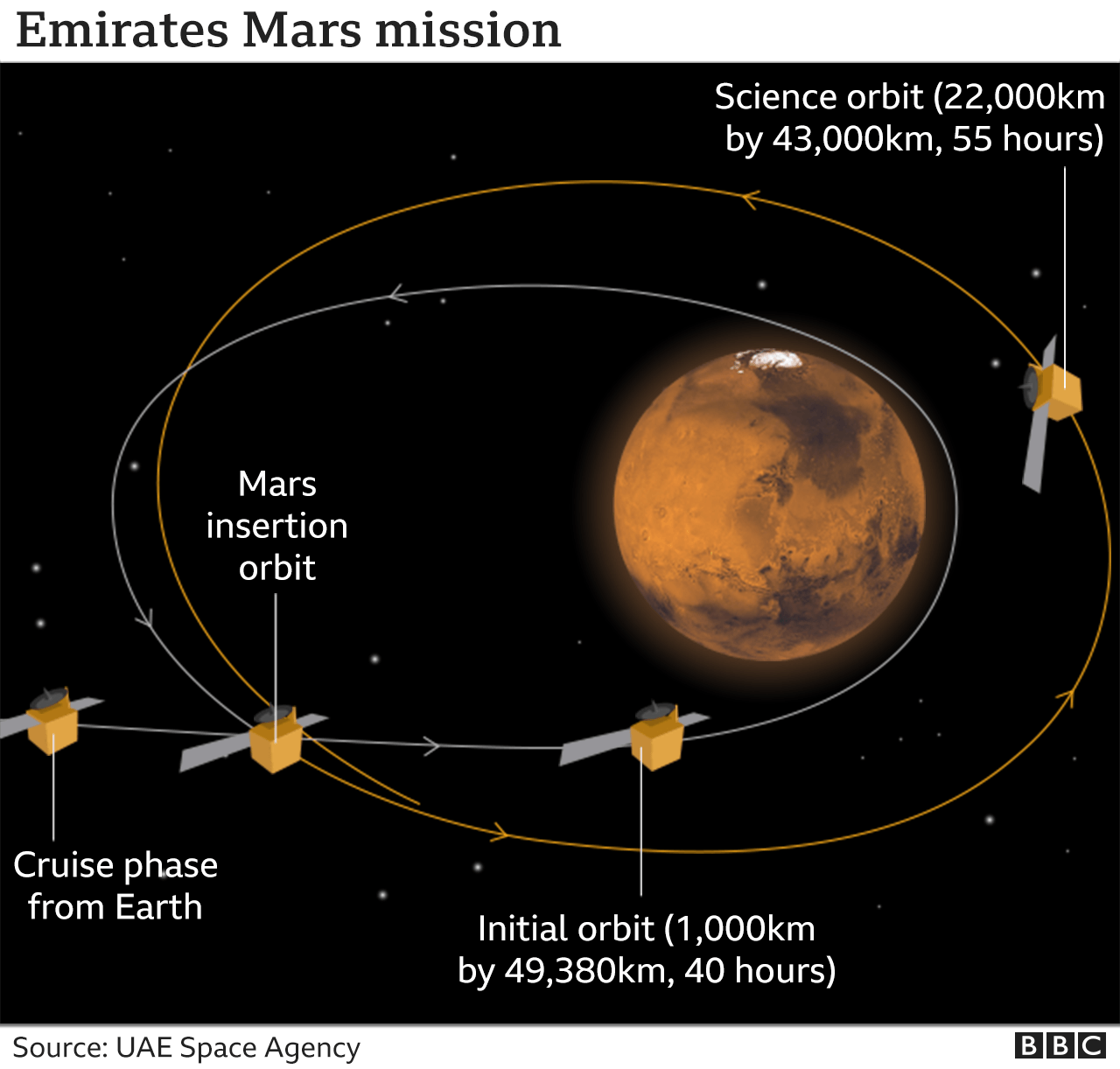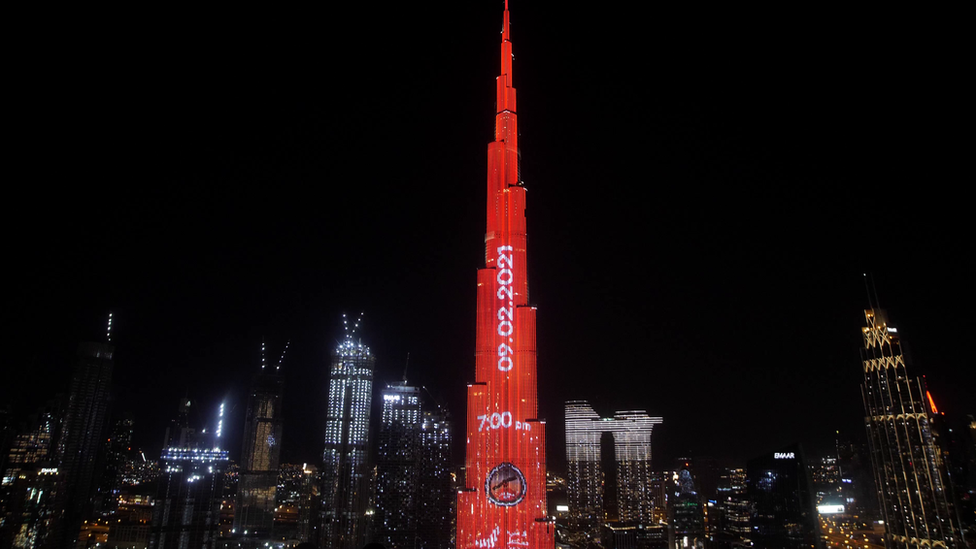Emirates Mars Mission: Hope spacecraft enters orbit
- Published

Artwork: Hope will study how energy moves through the atmosphere of Mars
The United Arab Emirates is celebrating its first mission at Mars.
It has put a probe called Hope in orbit around the planet, making it only the fifth spacefaring entity to do so after the US, the Soviet Union, Europe and India.
The spacecraft, which left Earth seven months ago, had to make a braking manoeuvre to be sure of being captured by Mars' gravity.
UAE scientists can now look forward to studying the planet's atmosphere.
Their satellite carries three instruments that will observe, among other targets, how neutral atoms of hydrogen and oxygen - remnants from Mars' once abundant water - leak into space.
In the process, Hope will return spectacular, high-resolution, full-disk images of the planet.

Tuesday marked the most critical phase in the mission.
Hope had been approaching Mars at over 120,000km/h (relative to the Sun) and needed to execute a precise 27-minute burn on its braking engines to scrub some of that speed or risk skipping off into ever deeper space.
The manoeuvre, performed by six thrusters on the probe, commenced at about 19:30 GST (15:30 GMT), with confirmation received at Earth some 11 minutes later - the delay being the time it took for radio signals to traverse the 190-million-km separation between Mars and Earth.

A socially distanced crowd had gathered in Dubai's Burj Park to follow events on a big screen
The official announcement on the burn's completion when it came was calm, and the applause relatively restrained. Perhaps it was the relief speaking after a nerve-shredding wait for the positive telemetry.
"Mars orbit insertion was the most critical and dangerous part of our journey to Mars, exposing the Hope probe to stresses and pressures it has never before faced," said Omran Sharaf, the Hope mission's project director at the Mohammed bin Rashid Space Centre
"With this enormous milestone achieved, we are now preparing to transition to our science orbit and commence science data gathering."

Illuminations on the Burj Khalifa had been counting down to orbit insertion
The past few days have witnessed tremendous enthusiasm for Hope and its mission, with public monuments, buildings and heritage sites across the federation all lit up in red.
Dubai's Burj Khalifa, the tallest human-made structure on Earth, had been flashing a countdown to Tuesday's big moment.
Hope is regarded as a triumph for a small gulf nation that dared to think seven years ago that it could inspire the next generation by launching the first Arab interplanetary space mission.
"We wanted to arrive at Mars; (I'm) really grateful, and it's like a weight of seven years has been lifted from my shoulders," said Her Excellency Sarah Al Amiri, UAE minister of state for advanced technology and chair of the UAE Space Agency.
"On arriving at Mars. I'm now truly looking forward to the scientific discoveries. And I truly hope this mission will impact an entire generation to strive to do things that are even bigger," she told BBC News.

The Hope probe weighed 1,350kg at launch, much of that fuel
Hope is now running in an initial ellipse around Mars that comes as close as 1,000km from the planet and goes out to almost 50,000km. Over the course of the next few weeks, this will be trimmed to a 55-hour, 22,000km-by-43,000km orbit that is inclined to the equator by about 25 degrees.
"It depends on what that initial orbit looks like but we would need around three manoeuvres to get into our science orbit," said propulsion engineer Ayesha Sharafi.
This path is very different to those of previous satellites which have tended to operate with greater proximity to Mars to facilitate high-resolution imagery of the surface and communications with landed robots.
But it's from this high perch that Hope plans to carry out some novel research. It's going to trace how energy moves through the atmosphere from the very bottom to the very top.

One of the slogans for the mission has been "Impossible is possible"
A key influencer in this respect is dust which can on occasions blow up into storms that envelop the entire planet.
"Dust plays a hugely important role in the Martian atmosphere. There are a few places on Earth where the atmosphere can be that dusty, but they're localised and maybe for short times," explained Prof David Brain, a University of Colorado at Boulder planetary expert who is working with the UAE team.
"Dust absorbs a lot of energy; it can become very warm and radiate energy. And so when you're talking about energy transport, dust is a much larger part of the big picture at Mars."
How long does it take to get to Mars and why is it so difficult?
Hope is leading a wave of missions to Mars this February.
On Wednesday, it will be the turn of China with its Tianwen-1 orbiter. Like Hope, it must complete a braking manoeuvre to be captured by the planet's gravity.
Tianwen-1 is carrying a rover that will be despatched to the surface, most likely in May.
Next week, on Thursday 18 February, the Americans will arrive at Mars with another of their big rovers. The Perseverance robot is being aimed at a crater that once held a giant lake. It will look for signs of fossilised life.
